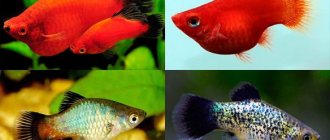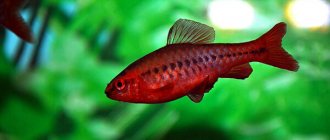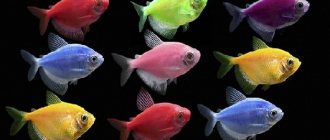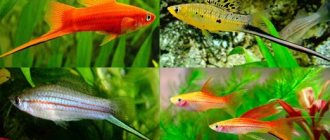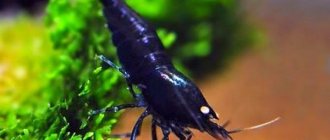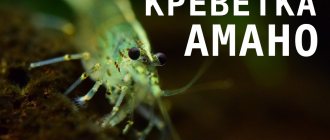Home › Aquarium shrimp › Types of aquarium shrimp ›
( 1 ratings, average: 5.00 out of 5)
There are a lot of interesting shrimps in India and nearby countries. However, their species status has not yet been determined and must be determined by scientists. Until this is done, all these unknown species are usually called by one common name - Caridina babaulti complex or babaulti shrimp.
Many varieties of shrimp and their trade names belong to this complex. These include Green babaulti (not to be confused with the Dark Green Shrimp), Indian Zebra Shrimp, Malaya Shrimp, Rainbow Shrimp, and Blueberry Shrimp. Blueberry Shrimp) and others. To complicate matters, there are several species of green shrimp in this group, as well as several species that are sold under the general name “rainbow.”
Table of basic parameters of maintenance, care and nutrition:
| What should be the volume of the aquarium? | from 5 liters |
| What should the temperature be? | from +22-28 °C |
| What should the pH be? | from 6.5-8 |
| What should be the stiffness? | from 8-20° dkH |
| What should be the substrate for an aquarium? | thin grains of the substrate (soil) ranging in size from 3-4 mm |
| What kind of lighting should there be? | moderate |
| What should be the movement of water | moderate |
| Aquarium Shrimp Size | 2-3 cm |
| What does aquarium shrimp eat? | zoo- and phytoplankton on moss; dead parts of plants; corpses of small fish; shrimp granules; live and frozen food; lightly cooked vegetables |
| Who is compatible with in an aquarium? | get along with small non-aggressive species, shrimp, fish, snails |
| Lifespan | 2-3 years |
General information
Filter shrimp (Atyopsis moluccensis) is a large freshwater shrimp that can be found on sale under a number of names: atyopsis, forest, banana or bamboo shrimp.
The key feature of these crustaceans is their amazing way of capturing food. The first two pairs of legs in shrimp are fan-shaped with numerous small hooks that catch and hold prey, as if filtering it from the water. In nature, shrimp catch microorganisms and small pieces of food.
These “crustaceans” are well compatible with most types of tropical fish.
Filter shrimp are the largest aquarium shrimp. The size of some individuals can reach 10 cm.
Appearance of green babaulti shrimp
In nature they can grow up to 4 cm, but in captivity they are no more than 2-3 cm in size. A special feature is the rostrum curved downwards.
Active and fast freshwater animals are bright green with a light stripe on the back, but can change it to light brown or red. It depends on the environment, mood and nutrition. It is usually difficult to find a natural rich color on sale. Aquarium inhabitants are pale green in color.
When they are not scouring the ground in search of food, they prefer to swim in the middle and upper water column. They are very timid, and at the slightest danger they hide in cover.
Description
The color of a shrimp can be different: green, orange, blue, brown, red, or a combination of several shades. The most common shrimp in aquariums are green, while blue and red ones are rare.
The color depends on the place where the shrimp was caught, and the shrimp itself is capable of changing color in seconds under stress.
The body is transparent, but under favorable conditions it acquires very rich colors, which is true only for green and red-brown individuals. A characteristic feature of this species is its long rostrum, which is strongly curved downwards.
Females are more massive, larger than males and more intensely colored. A sexually mature female can be distinguished by a small yellow-green spot on her neck.
The dimensions of the shrimp are quite small, 2.5-4 cm.
Maintenance and care
Babaulti green can live in a separate aquarium or a common one (but only if there are no potential enemies for it). The necessary conditions:
1. Volume from 5 l;
2. Soil: coarse river sand or fine gravel. A shrimp will look good against a dark background;
3. Various vegetation that serves as shelter. You should not plant Anubias and Cryptocorynes, whose roots emit a harmful toxin. You can put oak, beech, and walnut leaves on the bottom of the aquarium. You can purchase floating plants (various aquarium mosses, Pistia, Indian water fern), which will also serve as an additional filter;
4. Other decor - driftwood, stones;
5. Water:
- temperature from +22-28° C;
- from 6.5-8 pH;
- from 8-20° dH;
- high oxygen content;
- absence of heavy metals and nitrogenous compounds;
- change water by ⅓ every 2 weeks. Fresh water may be a little cooler.
6. Equipment:
- filter - the internal flow should not be strong. All holes where water is sucked in must be covered with a sponge to protect the fry;
- air compressor - for gas exchange;
- heater.
What to feed the green babaulti
Small crustaceans are undemanding in nutrition. They are small orderlies: they pick up the remains of half-eaten food from other animals, and love to feast on algae.
You can feed them separately with special dry food and tablets for catfish. For healthy development, fresh vegetables, fruits and herbs are necessary, which must first be poured with boiling water for 5-10 minutes for disinfection.
It is not recommended to feed food with a high content of animal protein - the shrimp begin to grow too quickly, which leads to problems with the shell and premature death. To ensure healthy development of the integument, food must contain enough calcium. You cannot overfeed; a single dose should be such that the shrimp can be eaten within half an hour. If there is a lot of food leftovers, the condition of the environment will worsen. You can arrange an unloading for a couple of days.
In order to enhance the color, add bell pepper. And almond leaves will not only serve as shelter, but will also have a beneficial effect on the health of shrimp.
The presence of a variety of mosses will never leave shrimp hungry. Herbal tablets and granules can be a good replacement.
The difference between a female and a male and their reproduction, breeding in an aquarium
Female representatives have a light green spot near the head, which is clearly visible against the background of the main color. Males are slightly smaller and less active.
The main advantage of babaulti is that their maintenance will not cause problems. You can even breed them with great success without moving them into a separate aquarium; they need fresh water. Shrimp reach sexual maturity at the age of approximately 3 months. Under favorable conditions, they can bear offspring 4-6 times a year.
The required temperature for reproduction is +25-26° C. The eggs in the female’s stomach develop in 3-4 weeks. Can bring up to 25 at a time.
The emerging fry (1-2 mm) are completely ready for independent life. Until they grow up, the aquarium must have shelters in the form of riccia and moss. For full development, babies are fed with single-celled, plant and animal plankton. Life expectancy is 2-3 years.
Growth and molting will be stimulated by frequent water changes - 2 times a week. The offspring may not necessarily have a green color. If the owner intends to breed shrimp of only this color, it is necessary to select the appropriate juveniles.
How to get rid
Aquarists who do not want to see coil snails in their underwater kingdom often think about how to get rid of them.
Let's look at the main methods:
- Biological. It consists of using aquatic organisms that will happily feast on the coils and will actively inhibit their growth. Botia, macropods, tetraodons, macrobrachium shrimp and, of course, predatory Helena snails can help in this matter. The complexity of the method lies in the need to create comfortable conditions for snail eaters.
- Mechanical. This is a manual collection of shellfish caught using some kind of bait. The most commonly used are scalded lettuce and banana peels. The coils are unable to pass by such a treat and pounce on it. After this, the bait is removed from the aquarium, and the process is repeated until the desired result is achieved.
- The chemical method is based on the use of specialized drugs to combat snails. Unfortunately, many of these products contain copper compounds, which are dangerous not only for shellfish, but also for any other invertebrates (shrimp, crayfish).
- A complete restart of the aquarium with mandatory treatment of the container, decorations, equipment, and soil is a total method of control, in addition, it is the most difficult and may not bring the desired effect.
Compatible with other shrimp, snails and fish
Based on its behavior, the Babaulti can be characterized as a friendly crustacean that does not bother anyone and lives its own life. The proximity to the same civilians suits him. Among the fish, these are Neons, Tetras, Rasboras, Swordtails, Corydoras, Mollies, Guppies, Norman's Blueeyes, Danios and others.
Colorful shrimp Cherry, Riley, Blue Dream will not only be wonderful companions, these crustaceans will perfectly complement the green color palette of Babaulti.
But you will have to give up any predators. Even protective coloring will not save you from the threat of becoming someone's lunch.
General information
Coils (Planorbidae) are a family of freshwater gastropods, widespread on almost all continents. Some species are frequent inhabitants of home aquariums, getting here mainly by chance (spawn or young snails are usually carried on plants). Although some aquarists keep them purposefully for the sake of variety or as food for certain types of fish.
Coils are unusually hardy mollusks, can exist in various water conditions, and reproduce easily and quickly. These invertebrates can breathe in two ways - using oxygen dissolved in water and atmospheric air.
The coils can breathe both oxygen dissolved in water and atmospheric
An interesting feature of the reels is the ability to move along the surface of the water with the shell down. The snails are helped to maintain balance by the air they draw into their shells when breathing. The support is the surface tension of water or a bacterial film. True, if you even slightly touch the snail at this time, it will immediately begin to sink. This allows them to escape from predators.
Coils are capable of multiplying very quickly, but this happens mainly in conditions of excess food, when the aquarist regularly overfeeds the fish.
The positive aspect of keeping coils is that these mollusks do not spoil plants, but they process dead leaves with a bang, being typical detritivores.
It is not recommended to bring coils from natural bodies of water into the aquarium. Gastropods are intermediate hosts of many types of parasites that are dangerous to fish.
Possible threats to shrimp
The cleanliness of an aquarium affects the health of its inhabitants. If fish get sick, sometimes it is necessary to use medications that can cause the death of other animals, for example, invertebrates. Crustaceans are particularly sensitive to copper, ammonia, nitrites and nitrates. If for other inhabitants their insignificant content does not matter, then for aquarium shrimp the presence of such substances should be reduced to zero. Do not use fresh water before starting. You can use conditioner or let the water sit, and there are also special tests to test the water. Let’s take a closer look at the harmful effects:
- Ammonia is formed as a result of the decomposition of organic substances and is a consequence of the release of waste products. High concentration leads to rapid death. You just need to carefully monitor the cleanliness of the aquarium: avoid overpopulation and overfeeding of any species, ensure good filtration;
- Nitrites are converted from ammonia by special bacteria. The increased content disrupts gas exchange in the body, oxygen starvation begins, and then death. If there is too much algae in the aquarium, this indicates the presence of nitrites;
- Nitrates are the result of the processing of nitrites under the influence of another group of bacteria and are less toxic. As a rule, there are not enough such organisms in a new aquarium;
- Copper - stronger than nitrites, can enter the aquarium through the water pipe. Heavy metal poisoning causes organ dysfunction and metabolic products are not eliminated from the body.
Any unusual behavior of shrimp - lethargy, inactivity, loss of appetite - is a clear sign of poisoning.
Shrimp can also be susceptible to bacterial infections if the condition of the aquatic environment has deteriorated or wounds of various types have appeared on the body. Bacteria, which are always present in the aquarium, attack the damaged organism.


